- Details
- Written by: Elmazen
- Category: Flags of Countries of the World
- Hits: 778
Flag of Antarctica - True South
Flag of Antarctica - True South, Currency, Population, Borders, Culture,Tourist Places
Antarctica is a unique and fascinating place, unlike any other on Earth.
Here is an overview of the topics you're curious about:
Flag of Antarctica, True South
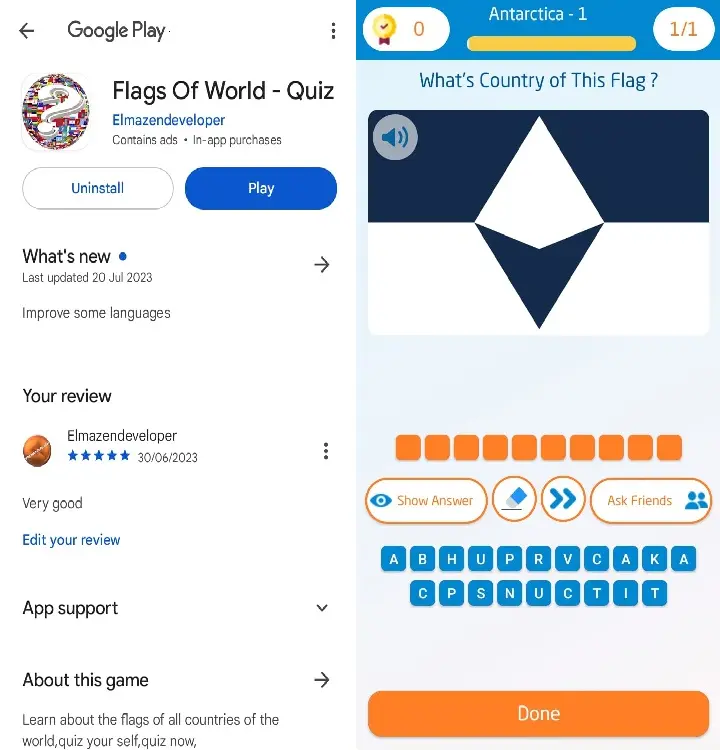
Download the application  Flags Of World - Quiz ,
Flags Of World - Quiz ,
And test your knowledge with Flags of World ,
1. Population of Antarctica
Antarctica does not have a permanent population.
Instead, it is home to temporary residents, primarily scientists and support staff, who live at research stations scattered across the continent.
During the summer months, the population can reach around 5,000 people, but this drops to approximately 1,000 during the harsh winter months.
2. Antarctica's Flag
Antarctica is not a country, so it doesn’t have an official flag like a sovereign nation.
However, the most commonly recognized flag associated with the continent is the "True South" flag, designed in recent years.
It features two horizontal bands of white and blue, symbolizing the ice and the Southern Ocean, with a central diamond representing the continent’s unique geography and the unity of the international community working there.
Alternatively, the United Nations flag is sometimes used unofficially to represent the spirit of international cooperation.
3. Currency of Antarctica
Antarctica does not have its own currency, as it is not a country.
Instead, researchers and staff typically use the currency of their home country or the currency associated with the nearest logistical base (e.g., the US Dollar, Euro, or Australian Dollar).
Transactions are minimal because most necessities are provided through research programs.
Flag of Antarctica, True South

Download the application  Flags Of World - Quiz ,
Flags Of World - Quiz ,
And test your knowledge with Flags of World ,
4. Borders of Antarctica
Antarctica is governed by the Antarctic Treaty System, which designates the continent as a demilitarized and neutral zone dedicated to scientific research.
While several countries have made territorial claims (e.g., Australia, Norway, and the UK), these claims are largely symbolic and not universally recognized.
Antarctica itself does not have political borders. Instead, it is surrounded by the Southern Ocean.
5. Culture of Antarctica
Antarctica does not have an indigenous population or culture due to its extreme conditions.
However, the culture of the research stations reflects a mix of traditions from the scientists' home countries.
Life in Antarctica revolves around collaboration, scientific discovery, and environmental conservation.
Informal traditions among the transient population include celebrating international holidays together, creating station-specific rituals, and maintaining camaraderie to endure the isolation and challenging environment.
6. Best Places to Visit in Antarctica
While Antarctica is primarily visited for research or adventure tourism, there are remarkable places to explore:
South Pole:
The southernmost point on Earth, a bucket-list destination for adventurers.
Ross Ice Shelf:
A vast floating ice shelf, often visited by researchers.
Lemaire Channel:
Known for its stunning scenery of towering cliffs and iceberg-filled waters.
Mount Erebus:
The southernmost active volcano on Earth, located on Ross Island.
Deception Island:
A volcanic island with geothermal springs, offering a unique contrast to the icy surroundings.
Antarctic Peninsula:
The most accessible and wildlife-rich region, featuring penguin colonies, seals, and whales.
Antarctica remains a land of mystery, beauty, and scientific discovery.
Its governance under the Antarctic Treaty serves as a model of international cooperation, reminding us of the importance of preserving this pristine and otherworldly environment.
Flag of Antarctica, True South

Download the application  Flags Of World - Quiz ,
Flags Of World - Quiz ,
And test your knowledge with Flags of World ,
- Details
- Written by: Elmazen
- Category: Flags of Countries of the World
- Hits: 710
Flag of Vanuatu
Flag of Vanuatu, Currency, Population, Tourist Places, Borders, Culture
Exploring Vanuatu: A Hidden Paradise in the Pacific
Vanuatu, an enchanting archipelago in the South Pacific Ocean, offers a unique blend of cultural richness, breathtaking landscapes, and a vibrant lifestyle.
Let’s dive into the details of this beautiful island nation.
Flag of Vanuatu
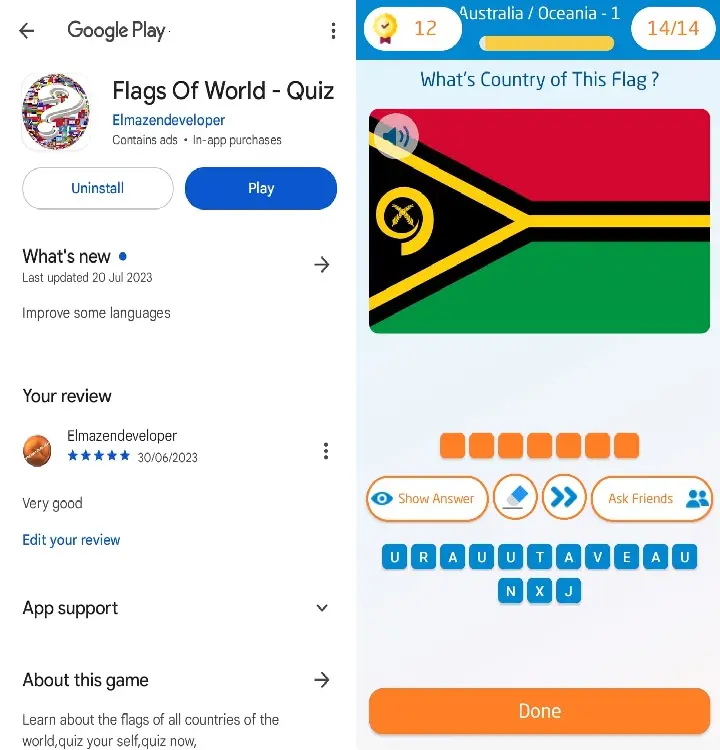
Download the application  Flags Of World - Quiz ,
Flags Of World - Quiz ,
And test your knowledge with Flags of World ,
1. Population of Vanuatu
As of December 2024, Vanuatu has an population of around 330,800 people.
The majority of the population resides on the larger islands, with Port Vila, the capital, being the most populous urban area.
The nation is known for its diverse communities, each contributing to the cultural tapestry of the islands.
2. The Vanuatu Flag and Its Meaning
Vanuatu's flag is a vibrant symbol of the country's identity.
It consists of four primary colors:
- Red: Represents the blood of boars and the sacrifices made for independence.
- Green: Stands for the fertile lands of the islands.
- Black: Symbolizes the Melanesian people, the indigenous inhabitants of Vanuatu.
- Yellow Y-shape: Represents the light of Christianity, a dominant religion in the country, and the shape of the islands on the map.
A boar's tusk and crossed namele leaves in the yellow stripe are traditional symbols of peace and prosperity.
3. Currency of Vanuatu
The official currency of Vanuatu is the Vanuatu Vatu (VUV).
The currency reflects the nation’s independence and economic self-reliance.
While cash is widely used, credit cards are becoming increasingly accepted in urban centers and tourist areas.
Flag of Vanuatu

Download the application  Flags Of World - Quiz ,
Flags Of World - Quiz ,
And test your knowledge with Flags of World ,
4. Vanuatu’s Borders
Vanuatu is an island nation with no land borders.
It is located in the South Pacific Ocean, northeast of Australia, west of Fiji, and south of the Solomon Islands. The country comprises 83 islands, 65 of which are inhabited, spread across 1,300 kilometers.
5. Culture of Vanuatu
Vanuatu's culture is rich and diverse, with over 100 languages spoken across the islands.
Key aspects include:
- Traditional Practices: Villages maintain age-old customs known as "kastom," including ceremonies, dances, and storytelling.
- Music and Dance: Bamboo instruments and traditional string bands are central to festivities.
- Food: Root crops like yam, taro, and manioc form dietary staples.
Traditional meals often include fresh seafood and vegetables cooked in underground ovens.
- Religion: Christianity is predominant, but traditional beliefs and practices persist in many communities.
6. Best Places to Visit in Vanuatu
Vanuatu is a dream destination for travelers seeking adventure, relaxation, and cultural experiences.
Must-visit places include:
Mount Yasur (Tanna Island):
An active volcano where you can witness spectacular lava shows.
Champagne Beach (Espiritu Santo):
Known for its crystal-clear waters and soft white sand.
Blue Holes (Espiritu Santo):
Natural freshwater swimming pools surrounded by lush greenery.
Port Vila:
The capital city offers markets, cultural experiences, and dining options.
Millennium Cave (Espiritu Santo):
A thrilling trek through caves and rainforests.
Pentecost Island:
Famous for its land-diving ritual, considered the precursor to bungee jumping.
Vanuatu offers a blend of natural beauty, cultural richness, and friendly locals.
Whether you're an adventurer, history enthusiast, or simply seeking tranquility, Vanuatu has something for everyone!
Flag of Vanuatu

Download the application  Flags Of World - Quiz ,
Flags Of World - Quiz ,
And test your knowledge with Flags of World ,
- Details
- Written by: Elmazen
- Category: Flags of Countries of the World
- Hits: 689
Flag of Tuvalu
Flag of Tuvalu, Currency, Population, Tourist Places, Borders, Culture
Exploring Tuvalu: A Hidden Pacific Gem
Tuvalu, a small island nation in the Pacific Ocean, is a remarkable destination with a rich culture, stunning natural beauty, and unique history.
Let's dive into some key facts and details about this fascinating country.
Flag of Tuvalu
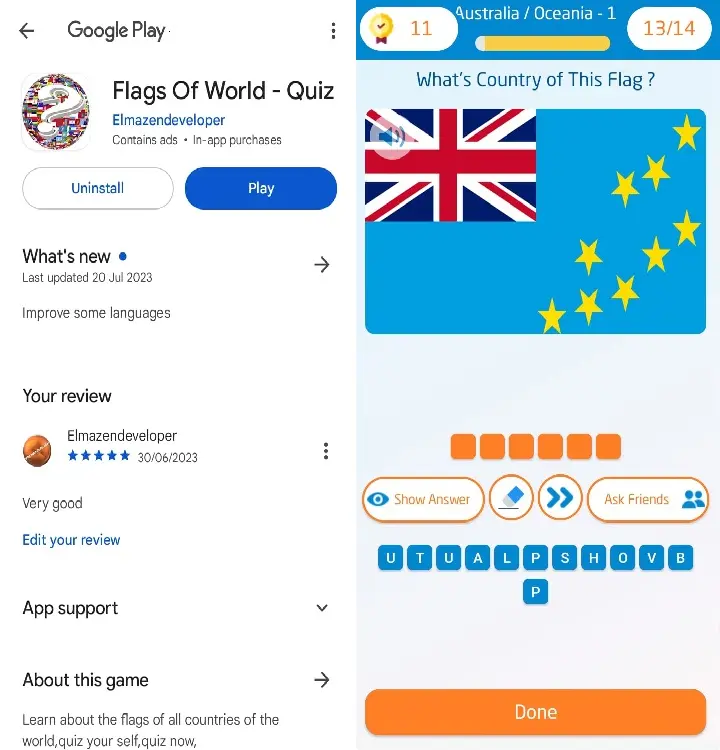
Download the application  Flags Of World - Quiz ,
Flags Of World - Quiz ,
And test your knowledge with Flags of World ,
1. Population of Tuvalu
Tuvalu is one of the world's smallest countries in both size and population.
As of December 2024, its population is approximately 9,580 people.
The majority of the population resides on the main island of Funafuti, which serves as the country's capital.
2. Tuvalu's Flag and Its Meaning
Tuvalu's national flag is a light blue field with the Union Jack in the top left corner, representing its historical ties to the British Commonwealth.
On the right side, there are nine yellow stars, each symbolizing one of Tuvalu's inhabited islands.
The blue background represents the vast Pacific Ocean surrounding the islands.
3. Currency of Tuvalu
Tuvalu uses two currencies:
- The Australian Dollar (AUD), which is widely accepted.
- Tuvalu also mints its own Tuvaluan coins, which are primarily used for commemorative purposes and small transactions within the country.
Flag of Tuvalu

Download the application  Flags Of World - Quiz ,
Flags Of World - Quiz ,
And test your knowledge with Flags of World ,
4. Borders of Tuvalu
Tuvalu is an island nation, meaning it has no land borders.
Its closest neighbors are Kiribati to the north, Fiji to the south, and Samoa to the east.
Tuvalu is surrounded by the Pacific Ocean, emphasizing its isolation and pristine environment.
5. Culture of Tuvalu
The culture of Tuvalu is deeply rooted in Polynesian traditions.
Key aspects include:
- Language: The official languages are Tuvaluan and English.
- Traditional Music and Dance: Performances like the Fatele, a rhythmic group dance, are integral to celebrations and ceremonies.
- Community Lifestyle: Islanders live in close-knit communities, where sharing and collective decision-making are central values.
- Religious Practices: Christianity, particularly the Church of Tuvalu, plays a significant role in daily life.
Art forms like weaving mats and fans from pandanus leaves are also important cultural expressions.
6. Best Places to Visit in Tuvalu
Despite its small size, Tuvalu offers incredible experiences for travelers:
Funafuti Lagoon:
A breathtaking natural wonder perfect for snorkeling, diving, and enjoying crystal-clear waters.
Nanumea Atoll:
Known for its serene beaches and historical World War II remnants.
Vaiaku Lagoon Side:
A charming area in the capital with waterfront views and local eateries.
Nukufetau Atoll:
Offers picturesque landscapes and traditional village life.
Philatelic Bureau:
For stamp enthusiasts, Tuvalu's unique and vibrant stamps are a must-see.
Conclusion
Tuvalu may be one of the smallest nations in the world, but it offers rich cultural traditions, friendly locals, and unparalleled natural beauty.
Its remote location and tranquil lifestyle make it an appealing destination for those seeking an off-the-beaten-path adventure.
Flag of Tuvalu

Download the application  Flags Of World - Quiz ,
Flags Of World - Quiz ,
And test your knowledge with Flags of World ,
- Details
- Written by: Elmazen
- Category: Flags of Countries of the World
- Hits: 736
Flag of Tonga
Flag of Tonga, Currency, Population, Tourist Places, Borders, Culture
Discovering Tonga: The Friendly Islands
Tonga, officially known as the Kingdom of Tonga, is a Polynesian archipelago in the South Pacific Ocean.
Known as the "Friendly Islands," Tonga boasts a rich culture, stunning landscapes, and a fascinating history.
Let’s dive into the essentials of this beautiful island nation.
Flag of Tonga
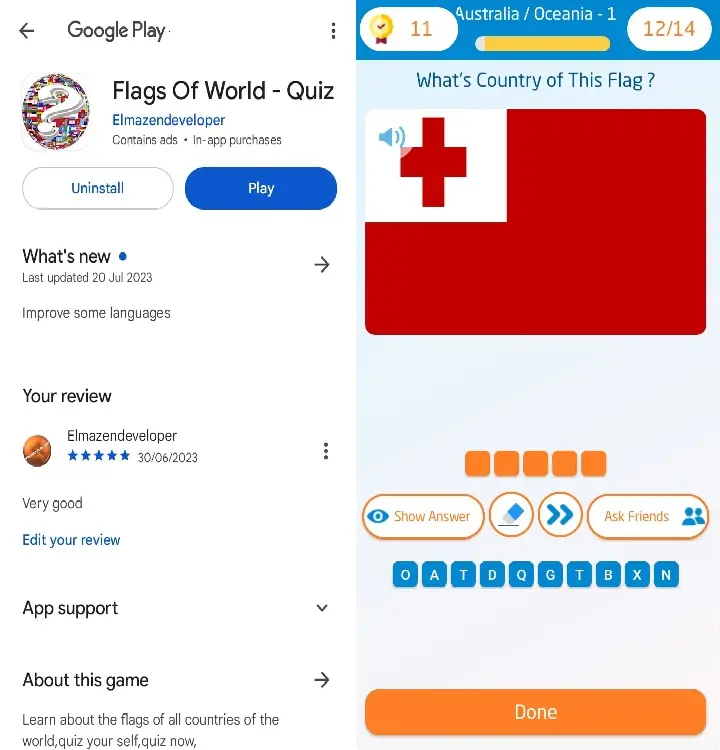
Download the application  Flags Of World - Quiz ,
Flags Of World - Quiz ,
And test your knowledge with Flags of World ,
1. Population of Tonga
As of November 2024, Tonga's population is approximately 104,000 people.
Most Tongans live on the main island of Tongatapu, where the capital city, Nuku’alofa, is located.
The population is predominantly Polynesian, with a small percentage of other ethnicities.
2. The Tongan Flag and Its Meaning
The Tongan flag features a red cross on a white square in the top left corner, set against a red background.
- The red cross symbolizes Christianity, which plays a significant role in Tongan society.
- The white background represents purity, while the red field signifies the sacrifice of Christ.
The design reflects the country’s deep Christian faith, introduced in the 19th century by European missionaries.
3. Tonga’s Currency
The official currency of Tonga is the Tongan paʻanga (TOP).
One paʻanga is subdivided into 100 seniti.
The currency is closely tied to the Tongan culture and economy, with coins and notes featuring traditional designs and important historical figures.
Flag of Tonga

Download the application  Flags Of World - Quiz ,
Flags Of World - Quiz ,
And test your knowledge with Flags of World ,
4. Tonga’s Borders
Tonga is a collection of 169 islands, 36 of which are inhabited, scattered over the South Pacific Ocean.
It does not share land borders with any country but is surrounded by other Pacific nations:
- To the west: Fiji
- To the north: Samoa
- To the east: Niue
- To the south: New Zealand is its closest larger neighbor.
5. The Culture of Tonga
Tongan culture is deeply rooted in Polynesian traditions and values.
Some key aspects include:
- Language: The primary language is Tongan, with English widely spoken as a second language.
- Religion: Christianity plays a central role, with Sunday being strictly observed as a day of rest and worship.
- Traditional Dress: The "tupenu" (a type of skirt) and "ta'ovala" (a woven mat worn around the waist) are common in formal and daily settings.
- Music and Dance: Tongan dances, such as the "lakalaka" and "tau'olunga," are vibrant expressions of storytelling and cultural pride.
- Family: Extended family, or "kainga," is central to social life, emphasizing respect and communal living.
6. Best Places to Visit in Tonga
Tonga offers a range of attractions that showcase its natural beauty and cultural heritage:
a. Haʻamonga ‘a Maui Trilithon
This ancient stone structure, located on Tongatapu, is often referred to as the "Stonehenge of the Pacific".
It is believed to have been constructed in the 13th century.
b. Mapu'a 'a Vaea Blowholes
These spectacular blowholes on the coast of Tongatapu shoot water high into the air as waves crash into the shore, creating a breathtaking natural display.
c. Vavaʻu Islands
A paradise for water activities, the Vavaʻu group is famous for whale-watching, diving, and snorkeling.
Visitors can swim alongside humpback whales during their migration season.
d. Pangaimotu Island
A short boat ride from Nuku’alofa, Pangaimotu is perfect for relaxing on pristine beaches, exploring shipwrecks, and enjoying local seafood.
e. Eua National Park
Located on the island of ‘Eua, this park is a haven for nature lovers, offering lush forests, hiking trails, and opportunities for bird-watching.
Conclusion
Tonga is a treasure trove of history, culture, and natural beauty.
Whether you’re drawn to its serene beaches, vibrant traditions, or warm-hearted people, the Kingdom of Tonga promises an unforgettable experience.
Flag of Tonga

Download the application  Flags Of World - Quiz ,
Flags Of World - Quiz ,
And test your knowledge with Flags of World ,
- Details
- Written by: Elmazen
- Category: Flags of Countries of the World
- Hits: 672
Flag of the Solomon Islands
Flag of the Solomon Islands, Currency, Population, Borders, Culture, Tourist Places
Exploring the Solomon Islands: A Pacific Paradise
The Solomon Islands is a beautiful archipelago located in the South Pacific.
Known for its stunning natural landscapes, rich history, and unique culture, this country offers an array of attractions for visitors.
Below, we’ll explore key facts and features of the Solomon Islands.
Flag of the Solomon Islands
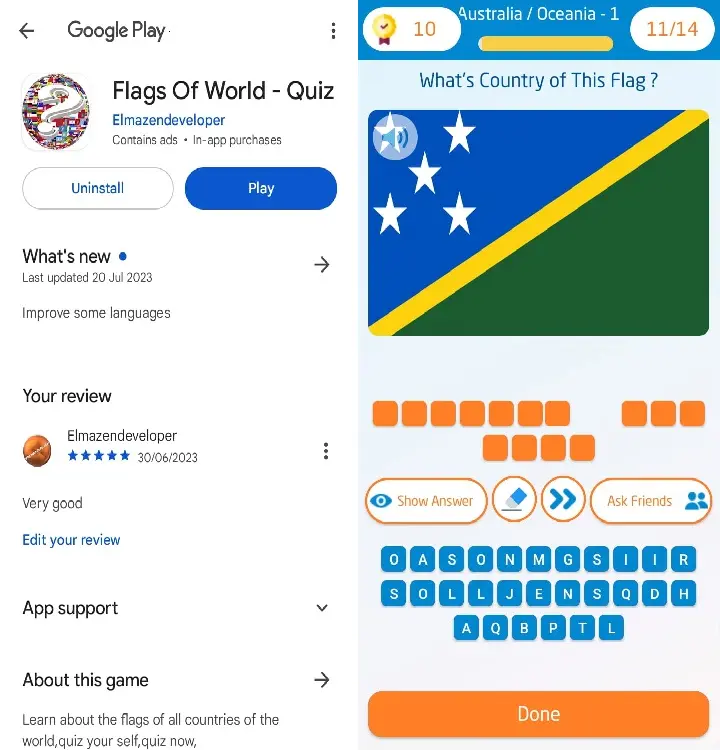
Download the application  Flags Of World - Quiz ,
Flags Of World - Quiz ,
And test your knowledge with Flags of World ,
1. Population of the Solomon Islands
As of November 2024, the Solomon Islands has a population of approximately 827,000 people.
The population is diverse, with over 70 different ethnic groups, primarily Melanesian, and smaller Polynesian and Micronesian communities.
2. The Solomon Islands Flag Meaning
The flag of the Solomon Islands consists of four main elements:
- Blue Triangle: Represents the ocean and the sky surrounding the islands.
- Green Triangle: Symbolizes the land and the islands' rich natural resources.
- Yellow Stripe: Depicts the sunlight and happiness.
- Five Stars: Represent the five main island groups in the country: Choiseul, Guadalcanal, Malaita, New Georgia, and Santa Isabel.
The flag reflects the country's geography and its connection to nature.
3. Currency of the Solomon Islands
The official currency of the Solomon Islands is the Solomon Islands Dollar (SBD).
It is used for all transactions within the country and is subdivided into 100 cents.
Flag of the Solomon Islands

Download the application  Flags Of World - Quiz ,
Flags Of World - Quiz ,
And test your knowledge with Flags of World ,
4. Borders of the Solomon Islands
The Solomon Islands is a sovereign archipelago in the South Pacific and does not share any land borders with other countries.
However, it is located near Papua New Guinea to the west and Vanuatu to the south.
Its strategic location in Oceania places it within close proximity to many Pacific nations.
5. Culture of the Solomon Islands
The culture of the Solomon Islands is deeply rooted in its Melanesian traditions.
Here are some cultural highlights:
- Traditional Music and Dance: Music plays a vital role, with panpipes and traditional drums commonly used during celebrations and rituals.
- Customary Practices: Many communities maintain kastom, or traditional practices, which include ceremonies, storytelling, and respect for elders.
- Languages: While English is the official language, over 70 local languages are spoken, reflecting the country's linguistic diversity.
- Cuisine: The diet consists mainly of fresh seafood, root vegetables like taro, and tropical fruits.
Traditional cooking methods often involve earth ovens.
6. Best Places to Visit in the Solomon Islands
The Solomon Islands offers breathtaking destinations for visitors seeking natural beauty and cultural experiences:
- Honiara: The capital city, located on Guadalcanal Island, offers historical World War II sites, including the Guadalcanal American Memorial.
- Marovo Lagoon: A UNESCO World Heritage Site, this is the world’s largest double-barrier reef system and a paradise for divers and snorkelers.
- Tetepare Island: The largest uninhabited island in the South Pacific, it’s known for its pristine forests and conservation efforts.
- Munda: A gateway to spectacular diving spots, coral reefs, and wreck dives.
- Rennell Island: A UNESCO-listed area famous for Lake Tegano, a massive freshwater lake surrounded by limestone cliffs.
- Gizo: A charming town known for its beaches, fishing, and local markets.
Conclusion
The Solomon Islands is a captivating destination, rich in culture, history, and natural beauty.
From its vibrant flag that symbolizes its essence to its pristine lagoons and cultural heritage, this Pacific nation offers something for everyone.
Whether you're a history buff, a nature lover, or an adventurer, the Solomon Islands beckon with open arms.
Flag of the Solomon Islands
